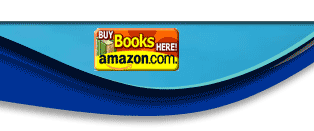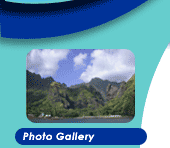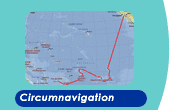August 1, 2004
Palau Marina Hotel, Koror, Palau
7° 30' N, 133° 30' E
A Taste of the Pacific Arts ![]()
By Lois Joy
“Seen one island, seen them all,” a cynical sailor once said to
me, having returned from the South Pacific to voluntarily go back to work—horror
of horrors! Now into the fourth year of our circumnavigation—having
cruised from California through the Marquesas, Tuomotus, Tahiti, the Cooks,
Niue, Tonga, Fiji and Vanuatu—I still cannot understand his blasé
attitude. Even though our yacht, Pacific Bliss, is now berthed in Australia,
I wanted to sample even more of the culture of these islands before we sailed
on to Indonesia and ports beyond.
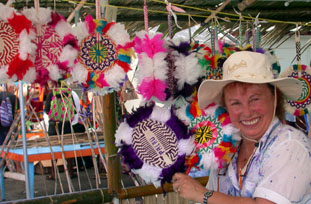 So
I talked Gunter into treating me to The 9th Festival of the Pacific Arts for
my birthday present this year. The Festival occurs every four years and changes
venues, like the Olympics, but that’s where the resemblance ends. It
is a celebration, not a competition, and the organization is island-style:
it just sort of flows from one event to the other. Attending The Festival
would be a fine finale to our South Pacific adventures and provide a taste
of those islands we hadn’t visited.
So
I talked Gunter into treating me to The 9th Festival of the Pacific Arts for
my birthday present this year. The Festival occurs every four years and changes
venues, like the Olympics, but that’s where the resemblance ends. It
is a celebration, not a competition, and the organization is island-style:
it just sort of flows from one event to the other. Attending The Festival
would be a fine finale to our South Pacific adventures and provide a taste
of those islands we hadn’t visited.
We arrived at the Palau Marina Hotel in the evening after a day’s layover in Guam following a flight from Cairns, Australia. In the lobby—decorated with bamboo furniture and giant shells—our taxi driver introduced us to the hotel’s Japanese owner. We bowed politely and conversed with him for awhile, the driver translating our English into Japanese. Then smiling Filipina waitresses led us to tables where we had an arrival dinner of sushi and Asahi. We climbed our way to our third floor room on leaden legs and crashed. We had two days to rest up before the action-packed Festival would begin.
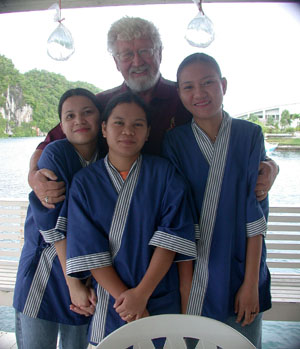 The
next day, we ordered the ‘morning set’ for breakfast: a semi-American
breakfast that included scrambled eggs and toast, grilled sausages cut at
a slant, and finely-shredded coleslaw with dressing. For lunch, we ordered
a bento; yakitori for me and squid for Gunter. The side dishes were quite
different from our old stand-bys at Ichiban’s in Pacific Beach, San
Diego: fishballs, poi-like sticky balls, spinach, seaweed and other little
delicacies that I could not identify. Emily—one of the trio of Filipinas
Gunter grew to love—fanned the flies as we dined on the veranda that
faces the peaceful harbor and the tantalizing Rock Islands beyond. The view
was a kaleidoscope of colors and patterns, the sea’s sun-sparkles giving
way to darkening wavelets as the wind freshened. A warm, tropical shower gently
drifted past the veranda, toward a perfectly-domed, mushroom-shaped island,
then morphed into rounded hills in a mist reminiscent of Japanese paintings.
I turned toward Gunter, “If this is the rainy season here, I won’t
mind.” Mind? I would subsequently take back those words as I became
intimate with the July-August weather north of the equator!
The
next day, we ordered the ‘morning set’ for breakfast: a semi-American
breakfast that included scrambled eggs and toast, grilled sausages cut at
a slant, and finely-shredded coleslaw with dressing. For lunch, we ordered
a bento; yakitori for me and squid for Gunter. The side dishes were quite
different from our old stand-bys at Ichiban’s in Pacific Beach, San
Diego: fishballs, poi-like sticky balls, spinach, seaweed and other little
delicacies that I could not identify. Emily—one of the trio of Filipinas
Gunter grew to love—fanned the flies as we dined on the veranda that
faces the peaceful harbor and the tantalizing Rock Islands beyond. The view
was a kaleidoscope of colors and patterns, the sea’s sun-sparkles giving
way to darkening wavelets as the wind freshened. A warm, tropical shower gently
drifted past the veranda, toward a perfectly-domed, mushroom-shaped island,
then morphed into rounded hills in a mist reminiscent of Japanese paintings.
I turned toward Gunter, “If this is the rainy season here, I won’t
mind.” Mind? I would subsequently take back those words as I became
intimate with the July-August weather north of the equator!
As we left the veranda for a sightseeing walk, a second shower appeared. This time it was the real thing. A trillion sharp-nosed bullets drove into the sea, until it was a mass of perforations, like a high tech sound studio. We decide to retreat to our room to take a ‘pensioners’ nap,’ a habit perfected in Australia.
Later, we donned rain jackets and picked our way across the pitted dead-end
street to the Palau Aquarium. The inside contains the best live displays of
marine life along a coral wall that I’ve ever seen. The outside pools
hold a shark, a hawksbill turtle, and a variety of large game fish.
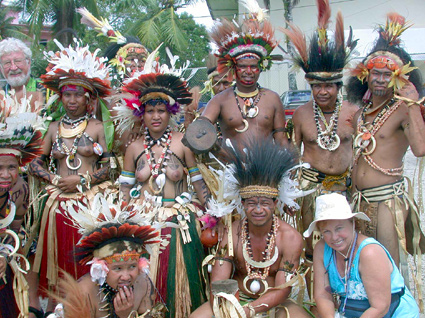
After the aquarium, we walked to nearby Fish & Fins to introduce ourselves. This premier dive-and-tour operation is run by an energetic Israeli couple who sailed their sailboat Ocean Hunter to Palau eight years ago, fell in love with the fabulous marine life here, and—like many cruisers we’ve run into during our voyages—decided to stay. They charter out their sailboat for overnight excursions to the Rock Islands, along with Ocean Hunter II, a motor dive boat. We checked on snorkeling tours for later in the week.
Remarkably, the Opening Ceremony on July 22nd began without the omnipresent rain. “Alii!” began Palau’s President Tommy Remengesau, Jr. “Our home is your home; our food is your food; our island is your island; everything that we have, we want to share with you…except our spouses…” (‘The Pacific Way’ has evolved.) Modeled after the Olympics, the delegates of 24 of the 27 participating nations marched or danced across the PCC Track and Field, each to their own country’s native music. Each delegation presented gifts to the dignitaries of Palau, a custom of these islands, staked a ‘box art’ gift into the soil, and then performed. And what a performance it was—absolutely awesome! For cruisers, I’d recommend The Festival over the Olympics anytime.
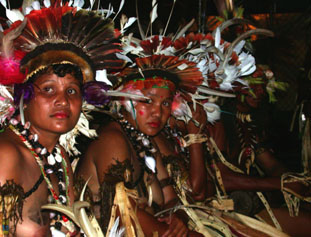 Gunter
and I privately declared the delegates from Papua New Guinea ‘best dressed,’
not that they wore a lot of clothes (see photo). We had the good luck to talk
with some of them briefly before the festivities began. They had flamboyant
headdresses, fierce faces, yet friendly dispositions. (Later, Gunter observed
two of these warriors holding hands as they ambled among the craft stalls.)
Gunter
and I privately declared the delegates from Papua New Guinea ‘best dressed,’
not that they wore a lot of clothes (see photo). We had the good luck to talk
with some of them briefly before the festivities began. They had flamboyant
headdresses, fierce faces, yet friendly dispositions. (Later, Gunter observed
two of these warriors holding hands as they ambled among the craft stalls.)
The Maoris of New Zealand were the most shocking to those attendees who had never witnessed their indigenous greeting: the warriors marched forward—eyes bulging, tongues stuck way out there, and spears thrust—while their women called out threats and twirled balls on the end of bungee-like cords.
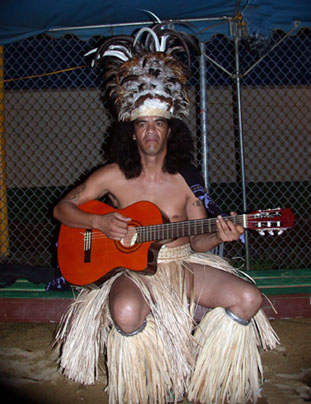 After
hours of speeches, performances and gift giving, box dinners of rice and fish
symbolizing a feast were handed out to all—yes, to every one of the
participants, the media, the organizers, the dignitaries, and the attendees
in the grandstand—all 8000 of us—because that is ‘the Pacific
Way.’ The opening ceremony lasted five hours—undeterred by a downpour
during the last two—and closed with dynamite fireworks, courtesy of
Taiwan.
After
hours of speeches, performances and gift giving, box dinners of rice and fish
symbolizing a feast were handed out to all—yes, to every one of the
participants, the media, the organizers, the dignitaries, and the attendees
in the grandstand—all 8000 of us—because that is ‘the Pacific
Way.’ The opening ceremony lasted five hours—undeterred by a downpour
during the last two—and closed with dynamite fireworks, courtesy of
Taiwan.
The Festival had multiple venues and activities from symposiums, movies and plays to crafts, culinary arts, and natural history tours. Sometimes it was difficult to choose. We decided to give dancing the priority. Each of the 27 participating islands sent a dance group; Taiwan, Japan and Indonesia sent performers as well. The dancing program continued day and night, at the ballfield, the stadium—and when it rained nonstop—the gymnasium.
 We narrowed our favorites down to half a dozen:
We narrowed our favorites down to half a dozen:
1. Papua New Guinea for exhibiting fierce demeanors, fabulous headdresses,
and flamboyant style.
2. Solomon Islands for dancing primitive rhythms while hunched over their
huge, homemade bamboo flutes.
3. The Cook Islands for toughest workout: sensuous male dancers knee-slapping
to a fast, pulsating drum beat, then twirling their women in perfect sync.
4. Rapa Nui (Easter Island) for the best choreographed routine— sophisticated,
yet invigorating—muscled bodies moving to a hot beat.
5. Yap (one of the Federated States of Micronesia) for an astounding Las Vegas
style, all-male, chorus routine—ending with pelvic thrusts bouncing
critically placed feathers.
6. Torres Strait, Australia, aborigines for dancing the most realistic stories
from their lives: when one dance demonstrated fishing, the dancer actually
fell to the floor, caught the bait with his teeth, and followed a fishing
line in. That performance raised the roof!
We were disappointed by the routines of the Hawaiian and French Polynesian dancers, so prim and polished that they lost the fresh dynamic of indigenous dancing.
It became clear that the music of the Polynesians, Melanesians, and Micronesians
reflected a common, linked heritage while the Asian ‘special performances’
were clearly different. The songs of the Taiwanese highland tribes, for example,
while 1000 years old, were quite sophisticated operatic arias with the typical
dissonant chords of Asian music.
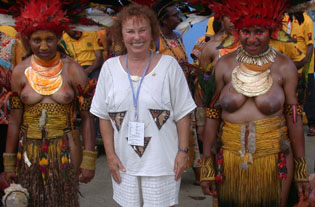 Imagine mingling with natives from 31 islands while you’re shopping
in the stalls, having lunch in Koror, or walking through the college campus
to attend a symposium. This ten-day extravaganza has to be the ultimate Pacific
tourist opportunity! We really got to know and love these island peoples as
never before. We talked with and photographed dancers before and after their
stage performances. Often dancers from other troupes were having their own
photos taken with them. By the end of The Festival, I could tell that the
participants were beginning to ‘mix it up.’ But it wasn’t
only the participants who were learning from each other. About 7000 attended
the Festival events each day, including about 3000-4000 Palauans. One native
Palauan turned toward me: “This is a tremendous once-in-a-lifetime experience.
I am proud to be a Palauan; I have seen my Pacific brothers and sisters and
now I know that there is no shame in being an islander.” In Pidgin,
this enlightened view is called Blong One Talk.
Imagine mingling with natives from 31 islands while you’re shopping
in the stalls, having lunch in Koror, or walking through the college campus
to attend a symposium. This ten-day extravaganza has to be the ultimate Pacific
tourist opportunity! We really got to know and love these island peoples as
never before. We talked with and photographed dancers before and after their
stage performances. Often dancers from other troupes were having their own
photos taken with them. By the end of The Festival, I could tell that the
participants were beginning to ‘mix it up.’ But it wasn’t
only the participants who were learning from each other. About 7000 attended
the Festival events each day, including about 3000-4000 Palauans. One native
Palauan turned toward me: “This is a tremendous once-in-a-lifetime experience.
I am proud to be a Palauan; I have seen my Pacific brothers and sisters and
now I know that there is no shame in being an islander.” In Pidgin,
this enlightened view is called Blong One Talk.
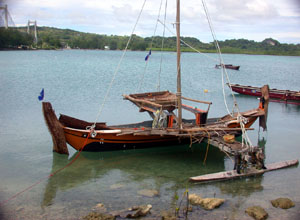 An
integral part of each year’s Festival is the Traditional Navigation
and Canoeing Program. As the smoke rose from the fire, the triton-shell trumpets
blared, and news helicopters hovered above, war and sailing canoes passed
below Palau’s KB bridge at sunrise on opening day. There were war canoes
from eight Palauan states and sailing canoes from Palau as well as Guam and
the Marshall Islands. (Missing sailing canoes from Yap and Saipan put a damper
on opening festivities, but they showed up later. After all, this is the monsoon
season in Palau, not a good time of the year for promoting the Canoe Program.
In the symposium, sailors advised the Committee to hold The Festival during
the sailing season if they expected to have more sailing vessels there. Makes
sense.)
An
integral part of each year’s Festival is the Traditional Navigation
and Canoeing Program. As the smoke rose from the fire, the triton-shell trumpets
blared, and news helicopters hovered above, war and sailing canoes passed
below Palau’s KB bridge at sunrise on opening day. There were war canoes
from eight Palauan states and sailing canoes from Palau as well as Guam and
the Marshall Islands. (Missing sailing canoes from Yap and Saipan put a damper
on opening festivities, but they showed up later. After all, this is the monsoon
season in Palau, not a good time of the year for promoting the Canoe Program.
In the symposium, sailors advised the Committee to hold The Festival during
the sailing season if they expected to have more sailing vessels there. Makes
sense.)
A few days later, the ‘scheduled’ races were held, although not one was even close to the schedule. We took a taxi to the Friendship Bridge where the finish line for the kabekl (war canoe) race was supposed to be and stood on the concrete jetty, cameras in hand. And we stood. Then we spread our rain jackets on the concrete. And we sat. After about two hours, the announcer on the other side described the two heats to be held by the canoes, to be followed by the play-off. About a half-hour later, he announced that, due to the delay, there would be no final race, only a 1,000 meter and a 500 meter. Some ladies dressed in red and white—with towels over their heads to protect them from the sun—were cheering for Palau’s Ngiwal State. I decided to follow their example. About a half-hour later, the race finally began. Everyone stood to cheer. The ladies towels were flying. The red team won. In the 500 meter, Koror won.
The advantage of all the waiting was that I had the chance to talk to islanders. One man explained how The Festival had spurred the sport of canoeing. “We’ve had races here before, but they are all with motor boats,” he said. “Our boys didn’t know how to race canoes. You should have seen them only a few months ago. They couldn’t even paddle!”
Come to think of it, I hadn’t seen any sailboats in the harbors except those used for excursions.
“Don’t they sail either?” I asked.
“No, the ancient Palauans navigated by the stars and all,” he said. “But then they didn’t need to sail to other islands anymore. We have everything we need here. And sadly, the tradition was not handed down.”
Carrying on those traditions and culture is the stated purpose of The Festival. But in the ‘traditional navigation’ symposium we attended, hoping to learn how to navigate by the stars, much of the discussion centered around intellectual property issues—how to prevent the usurping of traditional skills and knowledge by the west—as if we need them with the advent of GPS! Then the discussion turned toward how to get funding for the very program that some of the participants don’t want to share. The natives appeared oblivious to the dichotomy.
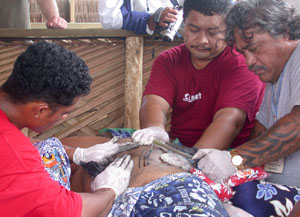 The
sailing canoe race was scheduled for 1300. This time, we took a taxi to where
the canoes actually were, thinking that we would be clever and position ourselves
at the start instead of the finish line. But we were also learning about ‘island
time.’ So Gunter kept our cab while I ventured toward the canoes.
The
sailing canoe race was scheduled for 1300. This time, we took a taxi to where
the canoes actually were, thinking that we would be clever and position ourselves
at the start instead of the finish line. But we were also learning about ‘island
time.’ So Gunter kept our cab while I ventured toward the canoes.
“When do you expect the race to begin?” I asked a group of potential racers who were preparing to barbeque their lunch. “At one o’clock,” one responded.
“But it’s one-thirty now.” I pointed to my watch.
“I think the race is actually at four o’clock,” another canoeist volunteered.
“No, the program says that is the time for awarding of the prizes. Do you have a program?”
“No.”
“Hold the cab, we’re leaving,” I called to Gunter.
We heard that the races did actually occur that day—at 1630. But two had decided not to race. Guam, Yap and Palau—although mismatched—managed to crawl to the finish line against the wind and current under the bridge.
One day when the monsoons were absent at breakfast time, we decided to skip out and go snorkeling in those wonderful Rock Islands we’d been viewing from the veranda every morning. We were pleased to see only six snorkelers on the Fish & Fins launch, giving us the opportunity to go to a lot of sites in one full day. After a 45-minute run pushed by two huge Yamahas, we were slowing through the German Channel not far from Peleliu.
The launch anchored in a shallow water spot called ‘The New Drop-off,’ near ‘The Ngemelis Wall,’ widely considered the world’s best wall dive, dropping from knee-deep water to almost 1000 feet. There are more than 1400 species of fish in Palau waters, and hundreds of species of corals. An underwater photographer friend once told me, “You can go to six different countries in the world to experience the greatest diversity of coral and fish, or just go to Palau.” He wasn’t kidding. As soon as Gunter and I approached the drop-off, a white-tipped shark swam lazily by. Green turtles and a lone hawksbill paddled by, unfazed. Small schools of blueline snappers hovered effortlessly, while fusilers, damsel and butterfly fishes accented the extraordinary view. I recognized species I’d seen in French Polynesia, Fiji, and Vanuatu, but in Palau, they were all together in one place. It doesn’t get any better than that.
Our second stop was Clam City, home of the world’s largest mollusks, four feet wide and up to 500 pounds. They rested in a sandy bottom eight to ten feet below as I floated over them, amazed. Their huge upholstered lips reminded me of a ‘70s-era furniture store filled with overstuffed sofas of lime green, orange, brown and rust.
Our launch pulled up for a box lunch on one of the Rock Islands among four other dive boats. We snorkeled again, but this time in company. One group of Japanese tourists swarmed en masse, a school of fish with snorkel-horns, back toward their dive boat. But soon our group was alone again, weaving alongside eagle rays through a channel lined with more mushroom-shaped, emerald islands. We anchored and swam in ‘The Milky Way,’ a natural Palauan beauty spa, where our guide brought up a bucketful of white sand to smear on our bodies and faces.
A once-in-a-lifetime experience awaited us in Jellyfish Lake, where one can swim with thousands of fragile jellyfish without getting stung. The lake has been cut off from the main lagoon eons ago, so without natural predators, their trailing tentacles have lost their sting. What Fish & Fins didn’t tell us was that we had to climb over a pass through a tangled jungle to reach the lake in the interior of the island! We were fortunate to have sturdy reef shoes instead of thongs. We picked our way along the steep coral-rock pathway supported by a handrail made of thick rope. The swim with the jellyfish was worth every bit of sweat getting there. They congregated in the green, murky water toward the middle of the lake. Once out there, the sensation was eerie, as the fragile tentacles brushed over my skin and in front of my mask. Some were the size of my hand; others were as small as a nail. They were all intricately delicate, like a butterfly’s wings.
We enjoyed two more snorkel stops on the way back: through coral gardens of staghorn, whip coral, sea fans, and brain coral—a kaleidoscope of colors ranging from blue-tipped to orange, red, yellow and sand.
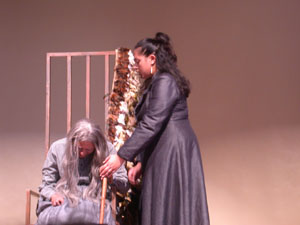 In
the days following, the festival activities kept us busy. We walked around
the Festival Village, purchasing souvenirs from various country booths and
sampling native food—both at the booths and at Koror’s local restaurants.
Each day, we walked through the thatched-roof Pavilion to view various tattooists,
carvers and weavers at work. An ongoing MAT project involved each country
weaving a 2x2’ piece that was then combined into one majestic quilt
of the Islands, to be displayed at the Belau (Palau) National Museum. Also
to be displayed at the Museum is a carved log with each country’s section,
and one large storyboard, the result of carvers’ combined efforts. There
were architectural displays, books and pamphlets on display, poetry readings,
instrumentals, and plays. One day, we took in a clever New Zealand stage play
that involved two actresses recounting the history of the Maoris from the
first sighting of the white man.
In
the days following, the festival activities kept us busy. We walked around
the Festival Village, purchasing souvenirs from various country booths and
sampling native food—both at the booths and at Koror’s local restaurants.
Each day, we walked through the thatched-roof Pavilion to view various tattooists,
carvers and weavers at work. An ongoing MAT project involved each country
weaving a 2x2’ piece that was then combined into one majestic quilt
of the Islands, to be displayed at the Belau (Palau) National Museum. Also
to be displayed at the Museum is a carved log with each country’s section,
and one large storyboard, the result of carvers’ combined efforts. There
were architectural displays, books and pamphlets on display, poetry readings,
instrumentals, and plays. One day, we took in a clever New Zealand stage play
that involved two actresses recounting the history of the Maoris from the
first sighting of the white man.
During the final days of The Festival, the rains arrived to stay. A typhoon was moving toward Japan; all of Micronesia was drenched in the resulting weather system. The closing ceremony was moved to the college gymnasium where all of the country delegations sat on the wooden floor in the center. Even so, the grandstands were overloaded, with many Palauans left standing outside under umbrellas, as the tiny country of 20,000 valiantly tried its best to be the perfect hosts to 4,000 visitors. We were touched by the warmth of the speeches and by the sincere effort to again feed the crowd in keeping with ‘The Pacific Way.’
“In today’s strife-torn world,” concluded Tommy Remengesau, Jr., “it is uplifting that so many of us have come together to celebrate the value and beauty of our heritage.”
May these Festivals continue to uplift, to teach, to inspire and to celebrate. Attending the 9th Festival of the Pacific Arts was a gift that will always have a special place in my heart. Readers of Latitudes & Attitudes, I highly recommend the 10th Festival, to be held in American Samoa in 2008!




